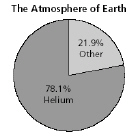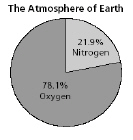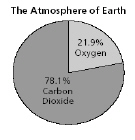Online Assessment
Instructions
1) Type in your first and last name in the
“Name” box in the top-left corner.
2) Next type in your teacher’s name in
the “ID” box.
3) Then type in your school’s full name in the
“Email” box.
4) Select the best answer for each question.
5) When you
are finished click the “Grade and Submit” button.
6) The grade will be emailed
to your teacher.
|
|
|
1.
|
NOTE: If your teacher’s last
name is Elliott, then you are doing the wrong assessment.
---This assessment is only for
students of other teachers.
---If your teacher is Mr. Elliott, then please go back to the
website and click on the first assessment link instead. Thanks!
Which gas in
Earth’s atmosphere suggests that there is life on Earth, and what evidence supports
this?
a. | Hydrogen, because this is the most common element in the
universe. | b. | Oxygen, because this gas is released by plants which are
alive. | c. | Carbon dioxide, because this gas is often released
during volcanic eruptions. | d. | Nitrogen, because
this element is used to make fertilizer for plants. |
|
|
|
2.
|
Diagram A | Diagram B | Diagram C | Diagram D |  |  |  |  | | | | |
Which three circle graphs shown above
INCORRECTLY represent Earth’s atmosphere?a. | B, C, and D | b. | A, B,
C, and D | c. | A, B, and D | d. | A, B,
and C |
|
|
|
3.
|
Which of the
following statements about the gases in Earth’s atmosphere is NOT
true? a. | All the gases in the atmosphere have reacted chemically
with each other forming compounds. | b. | Earth’s
first atmosphere contained much more carbon dioxide than our current
atmosphere. | c. | The largest
percentage of gas in our current atmosphere is nitrogen. | d. | Oxygen is the second most common gas in our current
atmosphere. |
|
|
|
4.
|
Millions of year’s ago, Earth’s
atmosphere was mostly carbon dioxide, water vapor, and ammonia.
Then photosynthesis significantly changed the
mixture of gases to form our current atmosphere.
Two-Part
Question
During
photosynthesis plants take in (1)_________ and (2)________.
a. | 1) oxygen from the atmosphere
2) release nitrogen into the air. | c. | 1)
nitrogen from the atmosphere
2) release carbon dioxide into
the air. | b. | 1) carbon dioxide from the atmosphere
2) release oxygen into the air. | d. | 1) sulfur from the
atmosphere
2) release nitrogen into the
air. |
|
|
|
5.
|
Which one of the following circle graphs correctly identifies Earth’s
current atmosphere?
|
|
|
6.
|
Which element is represented in
portion one in the circle graph shown above?a. | nitrogen | b. | hydrogen | c. | oxygen | d. | argon |
|
|
|
7.
|
Sector number two in the pie graph above BEST represents the percentage
of...?a. | Nitrogen | b. | Oxygen | c. | Carbon | d. | Argon |
|
|
|
8.
|
Two-Part Question
1) Identify the most abundant gas in Earth’s current atmosphere.
2) Identify one trace
gas in Earth’s atmosphere.
a. | 1) water
vapor
2)
hydrogen | c. | 1) carbon
dioxide
2) sulfur
dioxide | b. | 1) oxygen
2) Argon | d. | 1) nitrogen
2) water vapor |
|
|
|
9.
|
Earth’s Atmosphere Surrounds Our
Planet | | | | |
How does the large presence of oxygen in Earth’s atmosphere provides
evidence that life exists here?a. | Because this gas is the most common element in the
universe | b. | Because this gas is released by living creatures called
animals | c. | Because oxygen is released by living organisms called
plants | d. | Because this gas is commonly released by volcanic
eruption |
|
|
|
10.
|
The mixture of gases in Earth’s early
atmosphere contained much more carbon dioxide than our current atmosphere, and there was little
oxygen. Yet today’s atmosphere has about 22% oxygen.
Identify the process that altered the
mixture of gases in our atmosphere and increased the amount of oxygen.
a. | respiration from animals
(photosynthesis) | b. | respiration from
plants (photosynthesis) | c. | comets from space
brought H2O (water) which released O (oxygen) into the air | d. | volcanic venting released millions of tons of carbon dioxide and water vapor
in the air |
|